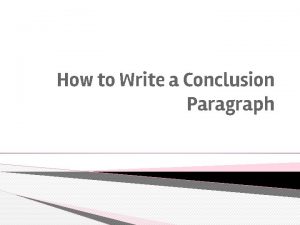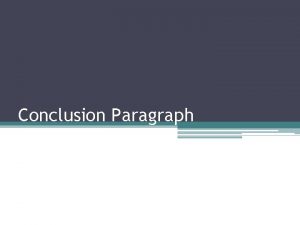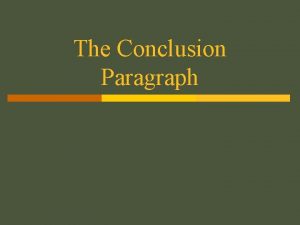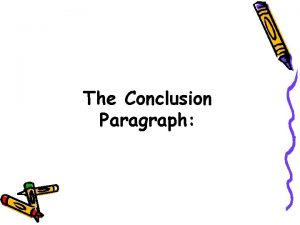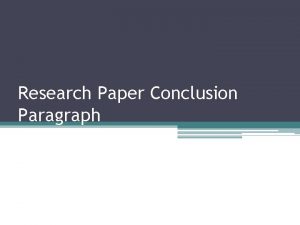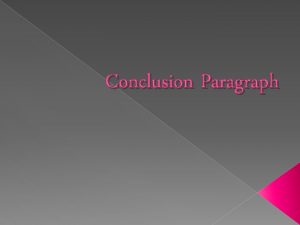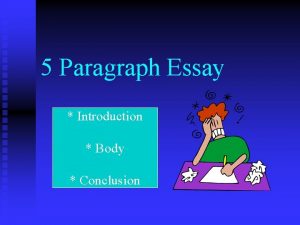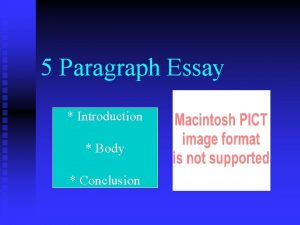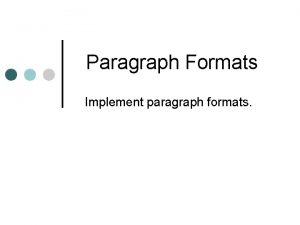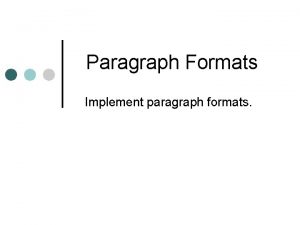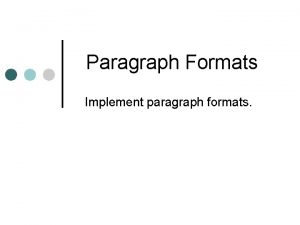THE CONCLUSION PARAGRAPH The conclusion paragraph in an
















- Slides: 16

THE CONCLUSION PARAGRAPH

• The conclusion paragraph in an essay of literary analysis functions as follows: • finishes off the essay and tells the reader where the writer has brought them. • It restates thesis and contains echoes of the introduction and body paragraphs without listing the points covered in the essay. • It creates a broader implication of the ideas discussed answers the questions: • so what? Or why do we care?

ANATOMY OF THE CONCLUSION • The conclusion begins with a restatement of thesis, not a repetition, and gradually widens toward a final , broad statement of implication. • Borrows from the body paragraphs, without being flatly repetitive or listing points already covered. • Creates echoes of the introduction and body paragraphs to reinforce analysis/ ideas. • Moves outward with a statement that relates thesis to a broader implication so the reader can see the analytical focus in a larger perspective or application.

STRATEGIES FOR COMPOSING CONCLUSIONS • • • Strike a note of hope or despair. Give a symbolic or powerful detail/fact. Create an analogy that relates your topic to a larger implication. Give an especially compelling example. Use a meaningful quotation. (If you used a meaningful quotation in your introduction, refer back to this quote and tie it in with your overall analysis. ) • Recommend a course of action without being “preachy. ” • Echo the language and approach of the introduction. • Reference and make meaning of the title of the work you are analyzing.

• Consider the following checklist when writing a conclusion: • Avoid first-person point of view, abstract/vague language, poor diction, and slang. • Avoid simply repeating thesis and/or listing the main points. • Don’t conclude more than you reasonably can from the evidence you have presented. • Echo the language and ideas from your introduction and body paragraphs.

CONCLUSION TO AVOID 1. The “That’s My Story and I’m Sticking to It” Conclusion This conclusion just restates thesis and is usually painfully short. It does not push the ideas forward. People write this kind of conclusion when they can’t think of anything else to say. Example: In conclusion, Frederick Douglass was, as we have seen, a pioneer in American education, proving that education was a major force for social change with regard to slavery.

CONCLUSION TO AVOID 2. The “Sherlock Holmes” Conclusion Sometimes writers will state thesis for the very first time in the conclusion. You might be tempted to use this strategy if you don’t want to give everything away too early in your paper. You may think it would be more dramatic to keep the reader in the dark until the end and then “wow” him with your main idea, as in a Sherlock Holmes mystery. The reader, however, does not expect a mystery, but an analytical discussion of your topic in an academic style, with the main argument (thesis) stated up front. Example: (After a paper that lists numerous incidents from the book but never says what these incidents reveal about Douglass and his views on education): So, as the evidence above demonstrates, Douglass saw education as a way to undermine the slaveholders’ power and also an important step toward freedom.

CONCLUSION TO AVOID 3. The “America the Beautiful”/”I Am Woman”/”We Shall Overcome” Conclusion This kind of conclusion usually draws on emotion to make its appeal, but while this emotion and even sentimentality may be very heartfelt, it is usually out of character with the rest of an analytical paper. A more sophisticated commentary, rather than emotional praise, would be a more fitting tribute to the topic. Example: Because of the efforts of fine Americans like Frederick Douglass, countless others have seen the shining beacon of light that is education. His example was a torch that lit the way for others. Frederick Douglass was truly an American hero.

CONCLUSION TO AVOID 4. The “Grab Bag” Conclusion This kind of conclusion includes extra information that the writer found or thought of but couldn’t integrate into the main paper. You may find it hard to leave out details that you discovered after hours of research and thought, but adding random facts and bits of evidence at the end of an otherwise-well-organized essay can just create confusion. Example: In addition to being an educational pioneer, Frederick Douglass provides an interesting case study for masculinity in the American South. He also offers historians an interesting glimpse into slave resistance when he confronts Covey, the overseer. His relationships with female relatives reveal the importance of family in the slave community.

• Expand on the implications of your analysis: • So what? Why do we care about these ideas? What’s so important about what you’ve developed in your paper? Are there any other applications for your ideas? • Avoid any attempts at humor, cuteness, or sarcasm. • The conclusion need not be longer than four to six sentences, as with the introduction, but must be adequately developed. • Include the title(s) and author(s) once more.

• Sample Conclusions: • Evaluate the strengths and weaknesses of the sample conclusions to follow. • Identify possible references to thesis statements, introduction, and body paragraphs. • Identify broader implications. • Identify and evaluate other strategies used.

SAMPLE 1 Both great works of epic literature from historical India and Japan certainly provide fascinating insights into the study of the idealization of women and wives. We can see how the different social conventions of each time and place have a defined impact on women’s roles within the institution of marriage. In reflecting on the societal expectations of a wife as represented in classical world literature we can gain new insights into women’s roles within marriage in a contemporary world. Future generations will look to our contemporary literature as a depiction of our society’s expectations and values of women not only as wives, but as single and independent women, as well.

SAMPLE 2 Edna’s character transforms from sleeping through life by meeting expectations to a great awakening, in which her thoughts and actions are consistent with each other. Edna’s struggle between her inner desires and her outward conformity is one in which her best solution was to satisfy no roles and expectations, including her own. Her character is so memorable because the reader can empathize with Edna’s internal conflict to both conform and defy. She is unforgettable because she does what each of us has wanted to do; her character resonates with the universal human condition of defying and abandoning societal expectations and impositions.

SAMPLE 3 The culmination of Stephen Dedalus’ linguistic and artistic development in James Joyce’s A Portrait of the Artist as a Young Man in indicated at the end of the novel when his story is no longer dependent on a narrator, but is told by Stephen himself through his journal. The journal entries are projected forth in the unfiltered language of the artist. He completes his linguistic journey, coming full circle from a child who merely perceives others’ language to the artist, who creates his own. The language implicit in Stephen’s journal represents the realization of his identity; his language displays the confidence and independence of one who is autonomous. At the end of the novel, Stephen’s physical, intellectual, and emotional transformations have been chronicled through the intricacies of language.

SAMPLE 4 Throughout Morrison’s Beloved memory has a power distinguished from other motifs in the novel. Memory is so pervasive that it functions as a separate character within the plot. It interacts with, and has a unique relationship with, each character; it brings up painful past experiences, and preys upon those resonances. Indeed, memory functions as an additional antagonist, dredging up the past, teasing and torturing without remorse the characters who attempt to forget. Ultimately, however, memory is defeated with Morrison’s dictate: “this is not a story to pass on. ”

SAMPLE 5 • The values of leadership portrayed by Tamburlaine’s character are still honored in society today. We desire a leader who is passionate and eloquent, but who is a leader of action, as well. We also value a leader who is proud and confident in his or her abilities and experience. Today’s leader’s would do well to consult Marlowe’s example of leadership in Tamburlaine.
 Hát kết hợp bộ gõ cơ thể
Hát kết hợp bộ gõ cơ thể Frameset trong html5
Frameset trong html5 Bổ thể
Bổ thể Tỉ lệ cơ thể trẻ em
Tỉ lệ cơ thể trẻ em Voi kéo gỗ như thế nào
Voi kéo gỗ như thế nào Tư thế worm breton
Tư thế worm breton Alleluia hat len nguoi oi
Alleluia hat len nguoi oi Kể tên các môn thể thao
Kể tên các môn thể thao Thế nào là hệ số cao nhất
Thế nào là hệ số cao nhất Các châu lục và đại dương trên thế giới
Các châu lục và đại dương trên thế giới Công thức tính thế năng
Công thức tính thế năng Trời xanh đây là của chúng ta thể thơ
Trời xanh đây là của chúng ta thể thơ Mật thư tọa độ 5x5
Mật thư tọa độ 5x5 Phép trừ bù
Phép trừ bù Phản ứng thế ankan
Phản ứng thế ankan Các châu lục và đại dương trên thế giới
Các châu lục và đại dương trên thế giới Thơ thất ngôn tứ tuyệt đường luật
Thơ thất ngôn tứ tuyệt đường luật

















